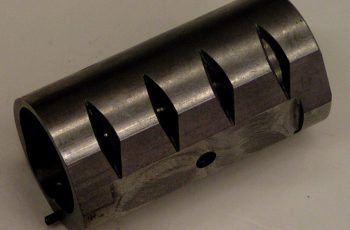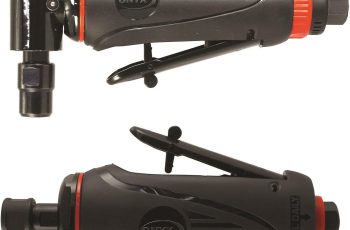When you’re working with variable speed die grinders, the RPM range plays a critical role in how effectively you can perform a task. You’ve got to strike the right balance between speed and precision, especially when you’re dealing with different materials. Too high, and you risk overheating; too low, and you might compromise efficiency. Curious about how to master this balancing act and truly optimize your tool’s performance?
Key Takeaways
- RPM range directly influences cutting speed, tool wear, and the risk of overheating in die grinders.
- Variable speed control enhances task efficiency by allowing RPM adjustments to match material types and specific tasks.
- Lower RPM settings extend battery life and reduce tool wear, improving overall longevity and performance.
- Proper RPM optimization prevents power loss, overheating, and ensures consistent material removal and finish quality.
- Brushless motors and electronic controls enable efficient RPM management, enhancing torque and precision in die grinders.
RPM and Power Output in Variable Speed Die Grinders
When it comes to variable speed die grinders, understanding the relationship between RPM and power output is fundamental for maximizing performance. You’ve got to focus on RPM optimization strategies to guarantee power efficiency. Die grinders typically range from 8,000 to 34,000 RPM, and balancing this with your grinder’s horsepower is essential. Higher RPMs might boost cutting speed but risk overheating and damaging abrasive materials. The Metabo die grinder, for instance, has a speed rating of 13,000 to 34,000 RPM, allowing for versatile performance across different applications. Conversely, lower RPMs protect your tools but might slow material removal. It’s imperative to match the power rating and RPM to your abrasive wheel—like using a 1″ flap wheel at 20,000 RPM versus a 3″ at 12,000 RPM. Stay below your wheel’s maximum operating speed to avoid tool wear and optimize efficiency.
Benefits of Variable Speed Control
Understanding the interplay between RPM and power output sets the stage for exploring the benefits of variable speed control in die grinders. With speed modulation, you can adapt to different materials and tasks seamlessly. Need to polish aluminum without damaging it? Lower speeds offer precision and reduce errors. This operational versatility means you won’t have to switch tools mid-task, saving time and effort. Plus, customizing speed extends the life of your accessories by preventing overheating and premature wear. Ergonomically designed with lighter handpieces, variable speed grinders reduce fatigue and guarantee smoother operations. This not only enhances your comfort but also boosts productivity. Ultimately, a variable speed control system consolidates your toolkit, offering efficiency and precision across a wide array of applications. Foredom tools, for example, function like a Swiss Army knife in the porting industry, providing a wide range of applications with various handpieces and attachments.
Accessory Compatibility and Efficiency
While optimizing your die grinder’s performance, it’s crucial to match accessory size with the appropriate RPM range. Proper accessory selection following RPM guidelines guarantees your tool operates efficiently and safely. Larger accessories, like 2-inch cutting wheels, typically need lower RPMs to avoid overheating and wear. Your die grinder might handle accessories from 1/8 to 2 inches, so always check the model specifications for compatibility. Using the correct RPM for each accessory not only enhances efficiency but also prolongs accessory life, reducing replacement costs. Quick-change spindle locks and versatile collet sizes, like 1/4-inch with reducing sleeves, expand your accessory options, allowing you to maintain workflow without compromising on precision or control. The M18 FUEL™ Variable Speed Braking Die Grinder offers variable speeds ranging from 8,000-20,000 RPMs, allowing for precise adjustments depending on the accessory size and application requirements.
Safety and Control Features
When using a die grinder, safety and control features are essential, especially with enhanced braking technology that swiftly stops the tool to prevent accidents. You’ll appreciate paddle switch modulation, which lets you maintain control without straining your hands, reducing fatigue during long projects. Additionally, technologies aimed at minimizing vibration and kickback guarantee a safer, more stable operation, so you can focus on precision and quality in your work. To further enhance user experience, options to select country/region for shopping and language preferences are provided, ensuring that you have the best possible tools tailored to your needs.
Enhanced Braking Technology
Incorporating RAPIDSTOP™ Braking Technology into die grinders greatly enhances safety and control, making it an essential feature for users. With its braking efficiency, the tool stops in under two seconds, markedly reducing the risk of accidents from spinning accessories. This rapid response boosts tool responsiveness, allowing for precise work during grinding or deburring tasks without sacrificing power. You’ll appreciate how this technology maximizes productivity by shortening downtime, letting you shift between tasks swiftly.
The integration of RAPIDSTOP™ with variable speeds ranging from 8,000 to 20,000 RPM guarantees you maintain control and safety across different applications. Additionally, REDLINK PLUS™ Intelligence provides electronic monitoring to prevent overloads, while ONE-KEY™ technology offers remote management, enhancing your safety and control over the tool.
Paddle Switch Modulation
Although die grinders pack a punch, safety and control are paramount, making paddle switch modulation an essential feature for users. Paddle switch ergonomics require continuous pressure, ensuring the tool shuts off instantly when released, thereby minimizing accidental startups. This design is vital for quick shutdowns in emergencies, markedly reducing injury risks during kickbacks or jams. Ergonomically designed grips reduce vibrations, enhancing comfort and lessening user fatigue over extended use.
The modulation benefits are clear—by allowing fine control over speed based on pressure applied, you can manage power output precisely, adapting to changing task demands. This not only aids in precision work but also extends tool and accessory life by preventing sudden, full-power stresses. Paddle switches align with advanced safety systems, offering thorough protection.
Vibration and Kickback Reduction
Paddle switch modulation isn’t just about control; it plays an essential role in reducing vibration and kickback, which are major safety concerns in die grinders. By adjusting speeds to match bit specifications, you achieve effective vibration mitigation, minimizing the risk of long-term injury. Proper bit seating and scatter dampening systems further enhance this by reducing vibration by up to four times. Meanwhile, kickback prevention is bolstered by features like electronic intelligence systems that monitor performance and provide overload protection. Braking technologies stop grinders swiftly, while ergonomic designs with soft grips guarantee stable handling. Regular maintenance, including checking bit alignment and condition, is crucial. By controlling these elements, you guarantee a safer, more efficient grinding experience.
Challenges of Variable RPM Die Grinders
While variable RPM die grinders offer versatility, they present several challenges that can impact both performance and safety. You might find the user experience complicated by the need for precise speed adjustments to match the task and material, avoiding damage. The lack of lock-on switches means constant input is required, leading to hand fatigue. Maintenance challenges arise from the greater wear on components like bearings and collets due to high and variable RPMs. Safety issues include increased risks of kickback and tool control loss at high speeds, with some models lacking essential electronic safety features. Inconsistencies in speed control can also lead to uneven results, while the absence of brakes can delay stopping time, further complicating safe usage.
Impact on Battery Runtime and Tool Life
Besides the challenges variable RPM die grinders present, their impact on battery runtime and tool life is equally significant. High RPM settings drain battery efficiency quickly, reducing runtime. Operating at lower RPMs, like 8,000-12,000, extends battery life by minimizing motor load and heat. Brushless motors enhance battery efficiency, offering longer runtimes by cutting down friction. For tool life, higher RPMs accelerate wear on components like bearings, threatening motor durability. Frequent high-speed use increases heat, degrading motor windings. However, variable speed control lets you match RPM to the task, optimizing battery use and preserving tool life. Electronic controls, like REDLINK PLUS™, manage power delivery, preventing overloads, while features like RAPIDSTOP™ reduce mechanical stress, ensuring longer tool longevity.
Influence on Material Performance
When you adjust the RPM range on your die grinder, you directly impact both the efficiency of material removal and the quality of the finish. Choosing the right speed for specific materials, like slower RPMs for hard metals, prevents overheating and wear, enhancing performance. By optimizing the RPM for each task, you guarantee not only efficient work but also prolong the lifespan of your tools and materials.
RPM Impact on Efficiency
For ideal grinding efficiency and material performance, it is crucial to match RPM settings to the specific task at hand. Implementing RPM optimization strategies allows you to enhance cutting speed and material removal by using higher RPMs, all while avoiding power loss from mismatched speeds. By employing RPM adjustment techniques, you can fine-tune the grinder to the material, improving efficiency and preventing overheating or damage. Higher RPMs, especially above 18,000, maintain consistent force, boosting operational output. Rapid RPM adjustments also enhance run time efficiency, allowing more tasks, like up to 35 pipe deburrs, on a single battery charge. With precise control, variable speed die grinders become versatile tools that maximize efficiency and performance across various materials.
Material-Specific Speed Optimization
Although die grinders are versatile tools, optimizing their RPM settings is essential for different materials. RPM optimization strategies guarantee that you get the best performance tailored to each material’s characteristics. For metalworking, consider material hardness; softer metals thrive on high RPMs for smooth finishes, while harder metals need lower RPMs to prevent overheating and wear. Wood and composites benefit from medium to high speeds, balancing removal rate and finish quality, with variable speed control adapting to each type. Stone and masonry require mid-range RPMs to prevent microfractures, while plastics need lower speeds to avoid melting. By fine-tuning the RPM settings, you enhance performance, extend tool life, and maintain material integrity across diverse applications.
Technology and Innovation in Die Grinders
In the domain of die grinders, technology and innovation have fundamentally transformed their performance and usability. With brushless advantages, these tools now deliver higher torque and efficiency by minimizing friction and heat. Brushless motors, integrated with electronic controls, support RPM ranges up to 28,000, making them perfect for precision tasks. The electronic integration allows for variable RPM with consistent power, optimizing battery runtime in cordless models.
Advanced variable speed control systems give you the flexibility to adjust speeds from 7,000 to 29,000 RPM, tailored for various materials. Safety features like fast-acting electronic brakes and overload protection enhance user safety. With ergonomic designs and accessory compatibility, die grinders offer improved control and reduced fatigue, making them indispensable in precision work.
Industry Applications and Use Cases
Die grinders are versatile tools with diverse applications across several industries. In the automotive sector, they’re essential for removing rust, paint, and imperfections, enabling smoother finishes and safer components. Die grinder applications extend to metalworking, where they remove burrs and weld spatter, prepare surfaces, and execute detailed engraving tasks. Woodworking benefits from their precision in sculpting and smoothing, with variable speeds protecting delicate materials.
In construction, angle die grinders excel in cutting and shaping materials like concrete and metal, enhancing industry performance through robust, ergonomic designs. For precision tasks, high RPM settings facilitate intricate detailing and polishing, producing high-gloss finishes. Across these sectors, die grinders’ adaptability, powered by variable speed control, guarantees efficient and safe operations.
Conclusion
When you’re using a variable speed die grinder, finding the right RPM for each task is essential. You’ll get the best results by balancing speed with tool longevity. High RPMs boost material removal but can wear out components, while lower RPMs are great for precision and protecting delicate materials. By understanding your tool’s capabilities and matching them to your work, you’ll enhance productivity, guarantee safe operation, and extend the life of your grinder.

